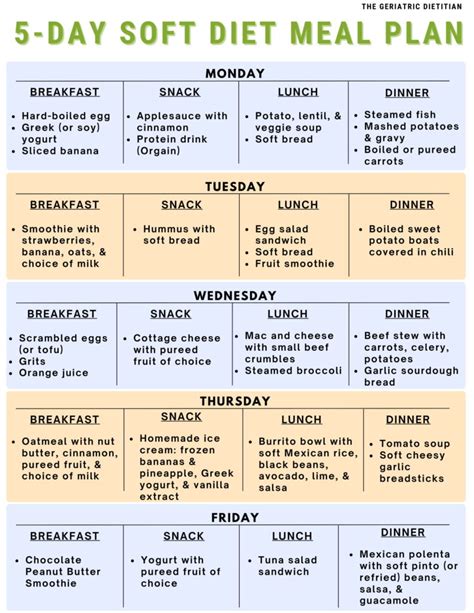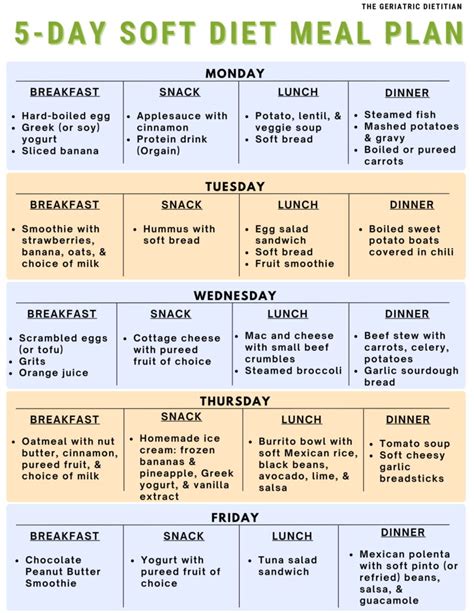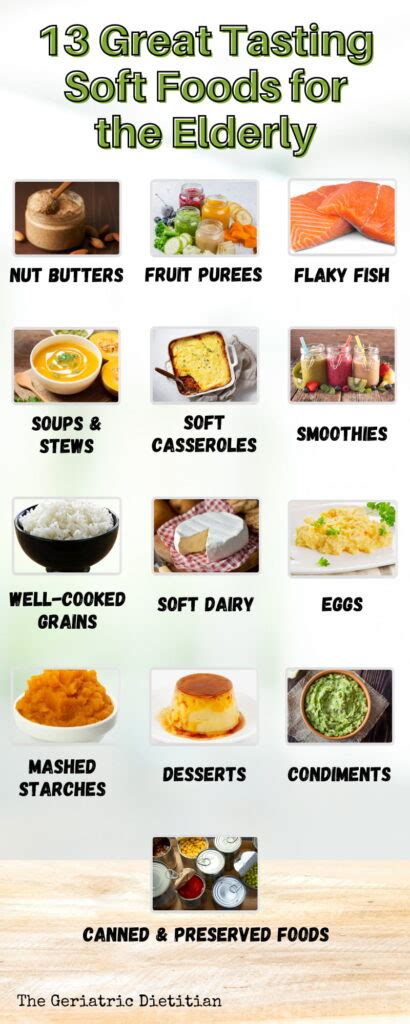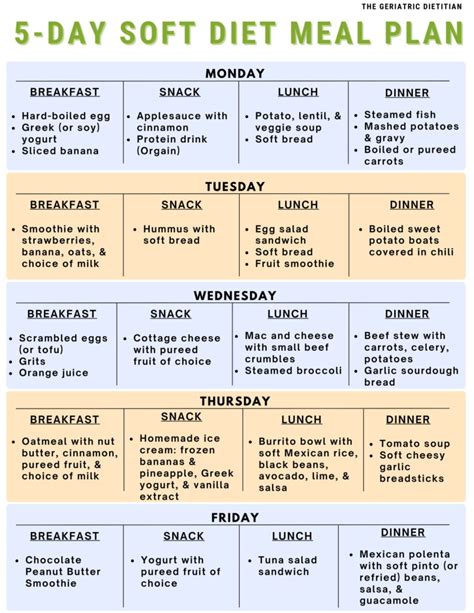Intro
Discover a gentle Soft Food Diet Plan with easy-to-chew recipes, pureed meals, and nutrient-rich options for digestive comfort, dental issues, and swallowing difficulties, promoting healing and recovery with a balanced and nutritious approach.
The importance of a soft food diet plan cannot be overstated, particularly for individuals who are recovering from surgery, experiencing dental issues, or dealing with digestive problems. A well-structured soft food diet plan can provide the necessary nutrients for healing and maintenance of overall health, while also being gentle on the digestive system. In this article, we will delve into the world of soft food diet plans, exploring their benefits, working mechanisms, and providing practical examples to help you get started.
A soft food diet plan is often recommended by healthcare professionals for patients who are undergoing treatment for various medical conditions. The primary goal of this diet is to provide easy-to-digest foods that are low in fiber and soft in texture, reducing the risk of discomfort, pain, or complications during the recovery process. By following a soft food diet plan, individuals can ensure that they are getting the necessary nutrients, vitamins, and minerals to support their overall health and well-being.
The concept of a soft food diet plan is not new, and it has been used for centuries to help individuals recover from illnesses and injuries. With the advancement of medical technology and our understanding of nutrition, soft food diet plans have become more sophisticated, taking into account the specific needs of each individual. Whether you are recovering from surgery, experiencing digestive issues, or simply looking for a gentle way to eat, a soft food diet plan can be a valuable tool in maintaining your overall health.
Benefits of a Soft Food Diet Plan

The benefits of a soft food diet plan are numerous, and they can be tailored to meet the specific needs of each individual. Some of the key benefits include:
- Reduced risk of discomfort or pain during eating
- Easy-to-digest foods that are low in fiber and soft in texture
- Provides necessary nutrients, vitamins, and minerals for overall health and well-being
- Can be customized to meet the specific needs of each individual
- Supports the recovery process after surgery or illness
- Can help to manage digestive issues, such as irritable bowel syndrome (IBS)
Working Mechanisms of a Soft Food Diet Plan
A soft food diet plan works by providing easy-to-digest foods that are low in fiber and soft in texture. This can help to reduce the risk of discomfort or pain during eating, making it an ideal option for individuals who are recovering from surgery or experiencing digestive issues. The working mechanisms of a soft food diet plan can be broken down into several key components, including: * Identification of easy-to-digest foods that are low in fiber and soft in texture * Customization of the diet plan to meet the specific needs of each individual * Gradual introduction of new foods to prevent discomfort or pain * Monitoring of progress and adjustment of the diet plan as neededSteps to Create a Soft Food Diet Plan

Creating a soft food diet plan can be a straightforward process, and it can be tailored to meet the specific needs of each individual. Here are the steps to create a soft food diet plan:
- Consult with a healthcare professional to determine the best course of action
- Identify easy-to-digest foods that are low in fiber and soft in texture
- Customize the diet plan to meet the specific needs of each individual
- Gradually introduce new foods to prevent discomfort or pain
- Monitor progress and adjust the diet plan as needed
Practical Examples of Soft Foods
Some practical examples of soft foods that can be included in a soft food diet plan include: * Soups, such as chicken noodle or vegetable soup * Pureed fruits and vegetables, such as applesauce or mashed potatoes * Cooked pasta, rice, or eggs * Soft-cooked meats, such as chicken or fish * Yogurt or cheeseCommon Mistakes to Avoid

When creating a soft food diet plan, there are several common mistakes to avoid. These include:
- Not consulting with a healthcare professional before starting the diet
- Not customizing the diet plan to meet the specific needs of each individual
- Introducing new foods too quickly, which can cause discomfort or pain
- Not monitoring progress and adjusting the diet plan as needed
Tips for Success
Here are some tips for success when following a soft food diet plan: * Start slowly and gradually introduce new foods to prevent discomfort or pain * Choose easy-to-digest foods that are low in fiber and soft in texture * Monitor progress and adjust the diet plan as needed * Stay hydrated by drinking plenty of water or other fluids * Consider seeking support from a registered dietitian or other healthcare professionalConclusion and Next Steps

In conclusion, a soft food diet plan can be a valuable tool in maintaining overall health and well-being, particularly for individuals who are recovering from surgery or experiencing digestive issues. By following the steps outlined in this article and avoiding common mistakes, individuals can create a customized soft food diet plan that meets their specific needs. Remember to start slowly, choose easy-to-digest foods, and monitor progress to ensure success.
Final Thoughts
A soft food diet plan is not a one-size-fits-all solution, and it requires careful planning and attention to detail. By working with a healthcare professional and following the tips outlined in this article, individuals can create a personalized soft food diet plan that supports their overall health and well-being. Whether you are recovering from surgery, experiencing digestive issues, or simply looking for a gentle way to eat, a soft food diet plan can be a valuable tool in achieving your health goals.What is a soft food diet plan?
+A soft food diet plan is a type of diet that consists of easy-to-digest foods that are low in fiber and soft in texture, reducing the risk of discomfort or pain during eating.
Who can benefit from a soft food diet plan?
+Individuals who are recovering from surgery, experiencing digestive issues, or dealing with dental problems can benefit from a soft food diet plan.
How do I create a soft food diet plan?
+To create a soft food diet plan, consult with a healthcare professional, identify easy-to-digest foods, customize the diet plan to meet your specific needs, and gradually introduce new foods to prevent discomfort or pain.
We hope this article has provided you with valuable information and insights into the world of soft food diet plans. If you have any questions or comments, please don't hesitate to reach out. Share this article with others who may benefit from a soft food diet plan, and take the first step towards achieving your health goals today!
